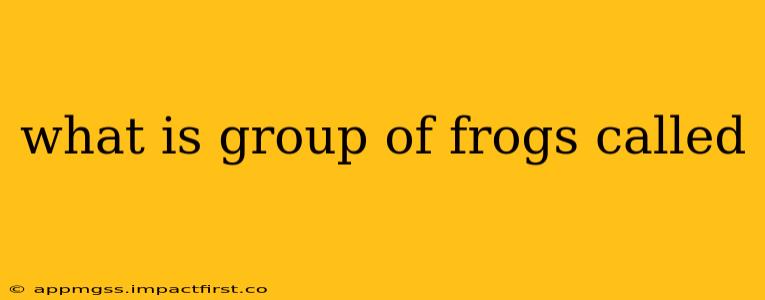A group of frogs is called an army. While it might seem surprising, this collective noun for frogs isn't just whimsical; it evokes a sense of the powerful, sometimes overwhelming, presence of a large gathering of these amphibians. Imagine a swamp teeming with hundreds of croaking frogs – it truly does feel like a small army!
This isn't the only collective noun used, however. The term isn't as standardized as some other animal groups, leading to some regional variations and poetic license. You might also hear people refer to a group of frogs as a colony, especially if they're clustered together in a specific habitat.
The choice of term often depends on context and the individual's preference, but "army" remains the most commonly accepted and widely used collective noun for a group of frogs.
Why Are Groups of Frogs Called Armies?
The term "army" for a group of frogs likely stems from their collective behavior and sounds. Imagine a large group of frogs calling in a chorus, especially during breeding season. The cacophony can be quite astonishing, creating a loud, powerful sound that's often described as overwhelming. This "army" of sound is quite fitting for the image conjured up.
Furthermore, the sheer number of frogs in a group can sometimes seem overwhelming, especially when considering their jumping and movement. This visual spectacle, combined with their chorus, reinforces the appropriateness of the term "army."
What About Other Collective Nouns for Amphibians?
While "army" is most commonly associated with frogs, other amphibians may have different collective nouns. For instance, a group of toads is sometimes called a knot or a nest. These terms reflect the often clustered nature of toads, unlike the more dispersed activity of some frog species. However, the use of collective nouns for amphibians remains less rigid than for some other animals.
What are some other collective nouns for animals?
This is a fascinating question in itself! The English language is rich with collective nouns, and they often reflect the nature and behavior of the animals in question. Here are a few examples:
- A pride of lions: Reflects the social structure and pride's cooperative hunting behavior.
- A flock of birds: Evokes the image of birds flying together in formation.
- A herd of elephants: Represents the large social groups in which elephants travel.
- A school of fish: Refers to the large groups of fish swimming together.
The rich variety of collective nouns showcases the imaginative ways we describe the natural world.
How many frogs are in an army?
There’s no specific number defining how many frogs constitute an "army." It's more of a descriptive term, suggesting a large and noticeable group. It could be dozens, hundreds, or even thousands depending on the context.
Do all frog species gather in large groups?
No, not all frog species gather in large groups. Many frog species are solitary or live in small family groups. The formation of large "armies" is more common in species that breed in large congregations or have specific habitat requirements that lead to high population densities.
